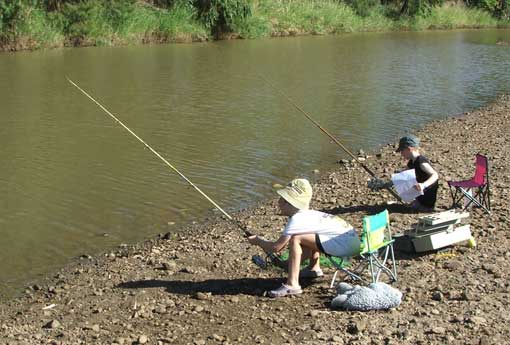For recreational fishers or community groups
For individuals or small community groups interested in reducing carp numbers, the main option is recreational fishing (including community fishing events).
This page also contains information for those interested in catch-and-release fishing for carp.
Recreational fishing (including community fishing events)
Is recreational fishing an effective method of carp control?
 Recreational fishing using legal methods (ie. handline and landing net) is a valid method of removing individual carp from waterways. If enough individual carp are removed over a period of time, this could potentially have some impact on the population.
Recreational fishing using legal methods (ie. handline and landing net) is a valid method of removing individual carp from waterways. If enough individual carp are removed over a period of time, this could potentially have some impact on the population.
However, research and anecdotal evidence suggests that carp fishing events often have limited effect on the carp population, with relatively low catches compared to the number of carp in the river system. For example, studies in NSW and Queensland have found the reduction in the carp population from fishing events to be around 0-2%.
For this reason, organisers should be careful not to overstate the expected impact of any single event on the carp population. It is fine to promote other benefits of the event aside from carp control, such as awareness-raising of a pest, promoting aquatic habitat regeneration, participation in a fun fishing event, social and economic benefits for the town and generating a sense of stewardship for the environment.
Can NSW DPI support or assist with our carp fishing event?
The Department does not receive funding and does not have resources to become directly involved in the running of events.
NSW DPI has an educational program funded by the Recreational Fishing Trust and staff attend a range of public events, including community fishing events, to help educate participants about responsible and ethical fishing. The decision whether to attend any particular event is made by NSW DPI depending on the availability of staff and the likelihood of reaching key target audiences.
Do I need a permit to hold a carp fishing event?
NSW DPI does not require permits for public carp fishing events. Participants must use legal fishing methods and be in possession of their valid NSW recreational fishing fee receipt (unless exempt under the regulations).
The event should also comply with NSW DPI's NSW Code of Practice for fishing competitions.
How do we get rid of captured carp?
Captured carp must be killed in a humane manner. Guidance on humane euthanasia of fish is available on the animal welfare page.
Wherever possible, captured carp should be utilised (eg. for human consumption, pet or stock feed or fertiliser). Where there are no options for utilisation, captured carp must be disposed of appropriately.
Catch-and-release fishing for carp
Is it illegal to return carp to the water?
It is not currently illegal to immediately return captured carp to the waters from which they were taken (defence under section 216 of the Fisheries Management Act). However, NSW DPI encourages recreational fishers to retain and utilise any captured carp rather than returning them live to the water.
Is it legal to run a business based on catch-and-release fishing for carp?
Under current regulations, no permit or licence is required from NSW DPI for someone to guide recreational fishers in public waters. However, the normal recreational fishing rules and regulations (including NSW fishing fee requirements and bag limits) apply to all participants.
Anybody wishing to operate a business which involves charging for the right to fish in a private waterbody (including dedicated facilities for catch-and-release fishing) should contact Aquaculture Management at Port Stephens (02 4916 3900) for further advice as a Class F (fishout) aquaculture permit may be required.
Why does NSW DPI sometimes release carp after capture instead of euthanasing them?
Sometimes researchers do return captured carp to the water as part of research programs, for example to determine the size of the carp population, determine the effectiveness of control techniques (tag/recapture studies), understand carp movements and migrations (eg. Passive Integrated Transponder [PIT], radio or acoustic tagging), aid targeted carp removal (eg. radio-tagging of individual ‘Judas’ carp to help locate schools for removal), or fish community studies. This work is always performed in accordance with a research project and permit issued under section 37 of the Fisheries Management Act.